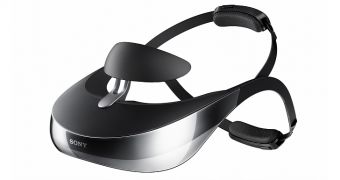Nowadays, when you say “augmented reality headset,” people might think of the Google Glass and other glasses (or contact lenses), but the original concept was far more immersive, as Sony likes to remind us.
Augmented reality is actually not an altogether accurate term to describe what the original idea was, since it's more like a totally different reality you wind up in. Visually at least.
Anyway, Sony reminded the world what augmented reality really was during the Consumer Electronics Show, 2014 edition, in Las Vegas, Nevada.
Between January 7 and January 10, it allowed people to put on what they call a “Wearable HDTV” which landed wearers inside a new world.
There, they could not only look at what was in front of them, but also turn their head up or down, and side to side, thus exploring more of the video scene.
The thing can be worn even if you have glasses on, although someone will need to help you to strap it properly, since while the big soft pad meant to rest on your forehead is easy enough to place, the straps around the back of your skull need to be adjusted by someone who can see what they're doing.
It's a good thing that the device is pretty light, at 11.3 ounces / 320 grams, otherwise you'd get pains in the back of your neck.
So how does it work? The Sony HMZ-T3W (that's the product name) provides a 170-degree field of view created through two HD images in 720p resolution delivered to each eye.
The screens measure 0.7 inches in diagonal and have slider knobs under them, to help you focus. Ultimately, the result is equivalent to viewing a 750-inch screen from 65 feet away (19.81 inches), or watching a 60-inch 3D TV from five feet / 1.52 meters.
The CES demo consisted of putting you on a motorcycle and racing down the English countryside, complete with clouds in the sky and crowds along the road.
Sadly, there are some issues to work out. Some testers found that there was a blind spot on the right, and they had to crane their neck further and further over time in order to look left. Later demos of the Sony HMZ-T3W are bound to have fewer problems like these though.

 14 DAY TRIAL //
14 DAY TRIAL //